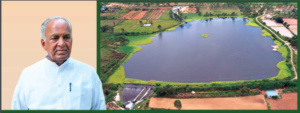In a groundbreaking effort to alleviate Karnataka’s crippling water crisis, a massive revival project is underway to restore over 3,500 dwindling water bodies across the state. This ambitious initiative aims to rejuvenate lakes, bogs and village tanks providing a lifeline to parched regions. At the heart of this endeavor are pioneering projects like Koramangala-Chellaghatta (KC Valley) and Vrishabhavati Valley (V- Valley) lift irrigation. These innovative ventures harness treated sewage water to replenish groundwater, bolster water security, and revitalize droughtstricken areas. The results are astounding: a tenfold surge in daily groundwater recharge and a remarkable increase in water levels.
This watershed moment in Karnataka’s water conservation journey promises a brighter future for the state’s agriculture, industry, and drinking water needs. As the region continues to battle water scarcity, this trailblazing initiative sets a shining example for sustainable water management and a beacon of hope for a water-secure tomorrow.” Under minister’s stewardship, the water bodies all over the state are now under schemes of the government which were never active in the past decades, Boseraju’s focus on water conservation, lake rejuvenation, and optimising river valleys for agriculture has captured national attention, earning approval from hydrology experts. The total Geographical area of the state of Karnataka is 19.04 million hectares. Due to the uneven distribution and failure of rainfall in most parts, the state is subjected to droughts often and often excluding the coastal and Malnad belts.

The ultimate irrigation potential in the state is assessed as 45 Lakh hectares from the surface water sources. Out of this, it is estimated that 10.00 Lakh hectares can be irrigated from Minor Irrigation projects. Projects having atchkat up to 2000 Ha. are classified as Minor Irrigation Schemes. Projects having atchkat between 40 Ha to 2000 Ha are under the jurisdiction of the Minor Irrigation and Ground water Development Department. These include Tanks, Pickup, Bhandaras, Barrages and Lift Irrigation Schemes. These Minor Irrigation projects are widely spread all over the state. As the major irrigation projects cannot be constructed at all locations and as the Minor Irrigation Projects can be speedily implemented they have gained vital importance.
Minor Irrigation and Ground Water Development Department is looking after the planning, designing, investigation, construction and maintenance of Minor Irrigation projects in the state. As on 1st April 2022, there are 10575 Minor Irrigation projects in existence under the jurisdiction of this department with a cultivable command Lakes, bogs and village tanks on the revival path M Raghuram Karnataka’s water bodies are on the revival path. Over 3500 water bodies in the state have been brought under the scanner, says Minister for Minor Irrigation and Science and Technology, N.S. Boseraju area of 874051.00 hectares. In addition to these projects, this department is looking after the operation and maintenance of 7 Medium Irrigation projects having a command area of 8342 hectares.
In-Depth: As fresh winds sweep across Karnataka under Chief Minister S Siddaramiah’s leadership, NS Boseraju stands out as a driving force. His tireless advocacy for integrating science and technology into governance resonates with the youth. Whether it’s revitalizing water bodies or enhancing groundwater and surface water management for agriculture, Boseraju’s pragmatic approach combines scientific rigor with practical solutions. Over the past eight months, the Departments of Minor Irrigation, Science, and Technology have embarked on a transformative journey. Their theme—“Governance for the Betterment”—has guided Karnataka toward a future marked by creativity, sustainability, and scientific excellence. Noteworthy initiatives include the “V-Valley project” (Vrishabhavati Valley), a sustainable response to the water crisis, and concerted efforts to raise groundwater levels in districts like Bangalore.

